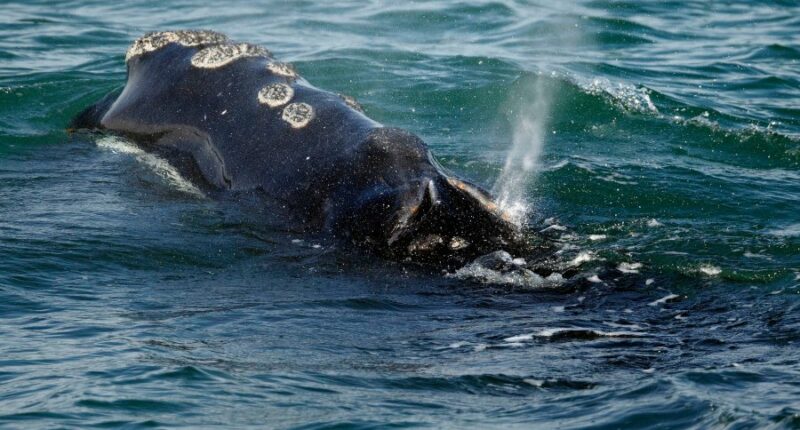Share this @internewscast.com

PORTLAND, Maine — In an optimistic turn for marine conservation, one of the world’s most endangered whale species, the North Atlantic right whale, has shown signs of a population rebound, buoyed by recent protective efforts. Researchers closely monitoring these majestic creatures have reported an uptick in their numbers.
According to the North Atlantic Right Whale Consortium’s latest findings, the population now stands at approximately 384 individuals, marking an increase of eight whales compared to the previous year. Over the past four years, these whales have experienced gradual population growth, with an impressive gain exceeding 7% from their numbers in 2020.
This positive trend is particularly heartening given the significant challenges the species faced in the last decade. Between 2010 and 2020, the North Atlantic right whale population suffered a concerning decline of about 25%, primarily due to threats like ship strikes and entanglement in fishing gear.
Philip Hamilton, a senior scientist at the New England Aquarium’s Anderson Cabot Center for Ocean Life, emphasized the critical role of conservation efforts in this gradual recovery. Together with the National Oceanic and Atmospheric Administration, the center works to provide accurate population estimates and implement protective strategies.
One key factor in this positive development has been new management strategies in Canada, particularly those aimed at safeguarding the whales in the Gulf of St. Lawrence, where their presence has been increasing. Hamilton noted the significance of these measures, stating, “We know that a modest increase every year, if we can sustain it, will lead to population growth. It’s just whether or not we can sustain it.”
“We know that a modest increase every year, if we can sustain it, will lead to population growth,” Hamilton said. “It’s just whether or not we can sustain it.”
Scientists have cautioned in recent years that the whale’s slow recovery is happening at a time when the giant animals still face threats from accidental deaths, and that stronger conservation measures are needed. But there are also reasons to believe the whales are turning a corner in terms of low reproduction numbers, Hamilton said.
The whales are less likely to reproduce when they have suffered injuries or are underfed, scientists have said. That has emerged as a problem for the whale because they aren’t producing enough babies to sustain their population, they’ve said.
However, this year four mother whales had calves for the first time, Hamilton said. And some other, established mother whales had shorter intervals between calves, he said.
In total, 11 calves were born, which is less than researchers had hoped for, but the entry of new females into the reproductive pool is encouraging, Hamilton said.
And any number of calves is helpful in a year of no mortalities, said Heather Pettis, who leads the right whale research program at Cabot Center and chairs the North Atlantic Right Whale Consortium.
“The slight increase in the population estimate, coupled with no detected mortalities and fewer detected injuries than in the last several years, leaves us cautiously optimistic about the future of North Atlantic right whales,” Pettis said. ”What we’ve seen before is this population can turn on a dime.”
The whales were hunted to the brink of extinction during the era of commercial whaling. They have been federally protected for decades.
The whales migrate every year from calving grounds off Florida and Georgia to feeding grounds off New England and Canada. Some scientists have said the warming of the ocean has made that journey more dangerous because the whales have had to stray from established protected areas in search of food.
Environmental groups warned Tuesday that the whales are still on the brink of extinction and need more aggressive protection to fully recover.
“Continued attacks on the Marine Mammal Protection Act and efforts to weaken NOAA’s science-based safeguards put this fragile population at even greater risk. We need Congress to uphold, not undermine, the laws, programs, and experts that give North Atlantic right whales a fighting chance for continued survival,” said Gib Brogan, senior campaign director with Oceana.
















